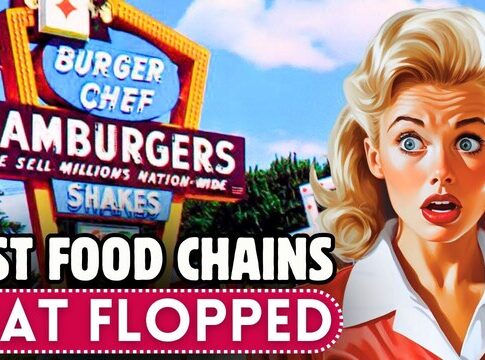The American landscape today is dominated by a few fast-food giants. But rewind to the mid-20th century, and the suburban highways were dotted with dazzling, competitive chains, each promising a unique burger, a revolutionary menu item, or a novel dining experience. These chains—like Burger Chef, Hot ‘n Now, and Henry’s Hamburgers—were cultural staples, local gathering spots, and ambitious pioneers.
Today, most are defunct. Their stories are a fascinating look at the volatility of the fast-food industry, where innovation wasn’t always enough to survive the relentless pressure of consolidation and changing consumer tastes.
When Competition Was King: The Rivals to the Throne
The period following World War II saw an explosion in car culture and franchising, providing fertile ground for rivals to the emerging national leaders. Many chains enjoyed tremendous success before faltering:
1. Burger Chef: The True Innovator
Founded in 1958, Burger Chef was, for a time, the second-largest burger chain in the nation, boasting over 1,200 locations. Their most enduring legacy? The Funmeal, a direct predecessor to the Happy Meal, and the invention of the self-service topping bar, giving customers control over their food. Despite their operational genius and beloved menu, a combination of intense competition from McDonald’s, corporate missteps, and a tragic incident in 1978 contributed to their ultimate absorption and disappearance.
2. Hot ‘n Now: The Drive-Thru Experiment
In the late 1980s and 1990s, Hot ‘n Now offered a revolutionary concept: ultra-cheap burgers and fries served exclusively via a drive-thru, promising speed and efficiency. Their success was so pronounced that they were acquired by PepsiCo’s restaurant division. However, this corporate shift led to ill-fated menu changes and failed attempts to expand beyond their regional strongholds, proving that sometimes, being a successful niche player is better than being a failed national experiment.
3. Henry’s Hamburgers: The Original Contender
Pre-dating both Burger King and Wendy’s, Henry’s Hamburgers was a powerful force in the 1960s, challenging the early dominance of White Castle and McDonald’s. With more than 200 locations, they marketed aggressively as the preferred choice for family dining. Like many early chains, they struggled to maintain consistency and adapt their business model during the 1970s recession, eventually shrinking into near-extinction, though a single, surviving location remains today as a nostalgic monument in Benton Harbor, Michigan.
https://www.youtube.com/watch?v=Wa2Jq9ELNRs
Beyond the Burger: Unique Concepts That Faded
Not every chain was focused on the simple burger. Many others tried to carve out a permanent niche with unique offerings and branding:
- White Tower: A clear imitator of White Castle, this chain utilized a similar architectural style and menu for decades, mostly focused on urban locations. Legal battles and intense competition eventually led to its decline as it struggled to differentiate itself from the original.
- The Training Table: A regional favorite, this Utah-based chain became a cult hit for its quirky, technologically forward ordering system: customers used table phones to call in their orders to the kitchen. Financial and legal issues, rather than food quality, brought an end to this unique dining experience.
- Minnie Pearl’s Chicken: Banking on celebrity endorsement, this fried chicken chain exploded with reckless overexpansion in the 1960s. Its rapid, chaotic growth, coupled with corporate mismanagement and financial scandals, serves as a cautionary tale of how fast expansion can lead to an even faster collapse.
- Winky’s: Known for the Big Wink sandwich and the friendly mascot “Winky,” this chain focused heavily on family dining throughout the 60s and 70s before being pushed out by larger, more aggressive competitors.
The Lessons of the Lost
The disappearance of these beloved brands highlights three critical truths about the fast-food industry:
- Innovation is Not Enough: Burger Chef pioneered the Funmeal and the self-service bar, but it couldn’t sustain its market share against McDonald’s superior franchising and marketing power.
- Corporate Consolidation is Brutal: Chains like Hot ‘n Now and Druther’s (which later became Dairy Queen Grill & Chill locations) were often acquired by larger firms, only to be dismantled or absorbed when they failed to fit the new corporate strategy.
- Adaptability is Key: Brands that failed to evolve with changes in health consciousness, real estate trends, and operational efficiency—such as those stuck in outdated urban models or those unable to finance modern drive-thrus—were quickly replaced.
While the majority of these chains are gone, their memory lives on in online communities and in the occasional surviving relic. They represent a vibrant, competitive, and distinctly American era of dining that paved the way for the industry we know today.


